 |
1. Status Panel: Each measurement features a unique status panel that displays settings and information relevant to the current measurement and view settings. 2. Markers: Markers are displayed as green diamonds on the trace to which they are assigned. The active marker is shown as a solid green diamond with a dashed vertical line. The marker amplitude and frequency are displayed in green text on the top left edge of the display. In this example, a marker is shown at the signal peak with the marker table enabled. Double-tap the marker to open a quick-access menu (refer to Marker Quick-Access Menu. 3. Limit Lines: Limit lines are shown as red (failing) or green (passing) lines with gray circles for each limit line point. Limit lines can be set up point-by-point or by using the envelope feature to quickly set a sloped or square envelope. The currently selected limit line point is shaded gray. When limit lines are enabled, a pass/fail status is shown in the upper right of the window. If the trace crosses the limit, the trace color will turn red and the limit will indicate a failure. The limit is only applied to the active trace (refer to Setting Trace and Cursor Parameters), which is indicated next to the pass/fail. 4. Measurement Settings: The x-axis shows the start, center, and stop frequencies. The y-axis displays the amplitude of the graticule lines. RBW/VBW, span, sweep time, and number of trace point settings are shown along the bottom of the spectrum display. If either resolution bandwidth or video bandwidth is set to manual, the “#” symbol will precede its label. If an offset frequency is entered, the offset value is displayed in the left side status panel. Pressing any of the editable parameters opens the keypad to edit the value directly. Information-only displays cannot be changed. 5. Multiple Trace Display: Each trace has a unique color and each can be set to Clear/Write, Average, Min or Max Hold, Rolling Average, or Rolling Min or Max Hold. Each trace can have Peak, RMS/Average, or Negative detectors. Traces can be set to Active, Hold/View, or Blank. |
